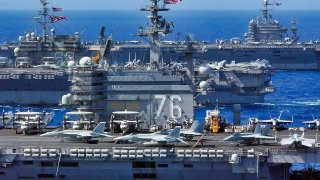U.S. Aircraft Carriers Keep Getting 'Sunk' by 'Old' Diesel Attack Submarines
Naval exercises have repeatedly demonstrated the effectiveness of diesel-electric submarines against much larger and technologically advanced adversaries. Notable instances include the Swedish Gotland-class submarine's virtual defeat of the USS Ronald Reagan during a 2005 war game and similar successes by German and Australian submarines against other U.S. carrier strike groups in various exercises.
Summary: Naval exercises have repeatedly demonstrated the effectiveness of diesel-electric submarines against much larger and technologically advanced adversaries. Notable instances include the Swedish Gotland-class submarine's virtual defeat of the USS Ronald Reagan during a 2005 war game and similar successes by German and Australian submarines against other U.S. carrier strike groups in various exercises.
-These exercises highlight the ongoing relevance of conventional submarines in modern naval warfare, challenging the security of carrier groups and underscoring the need for continuous advancements in anti-submarine warfare tactics.
Underwater Stealth: How Diesel Submarines Outmaneuvered US Aircraft Carriers in War Game
Naval exercises are conducted to help ensure that sailors are prepared for the "real deal" – hoping it will never come. It is often said that "We train like we fight;" and valuable lessons are learned from that training.
The National Interest has previously reported how during a 2005 war game involving the U.S. and Swedish navies, a $100 million Gotland-class submarine successfully foiled an entire American carrier strike group (CSG) that included the $6 billion Nimitz-class nuclear-powered supercarrier USS Ronald Reagan.
As noted by Harrison Kass, "During the war game, the Gotland was tasked with attacking the Ronald Reagan against the entire might of the CSG defending it. The CSG was the heavy favorite, but the Gotland was able to elude the supercarrier's passive sonar defenses and land multiple virtual torpedo strikes. The hypothetical damage inflicted would have been enough to sink the carrier."
That incident served to question the future role of supercarriers – yet, it wasn't exactly news, as the U.S. Navy's nuclear-powered flattops had previously fallen victim to old-school subs.
The German Submarine vs. The Enterprise Aircraft Carrier
In 2001, the German Type 206 diesel-electric submarine U24 – designed to operate in the shallow Baltic Sea and built in the 1960s – was deployed to JTFEX 01-2 naval exercises in the Caribbean Sea and managed to break through all the security around the USS Enterprise (CVN-65). The submarine fired green flares and took photographs of the U.S. Navy's flattop, essentially "sinking it."
"The U-24 could have rammed the aircraft carrier, the boat was that close," a submariner serving on the U-24 told the German outlet T-Online in 2013.
Australia's Collins-class vs. the USS Abraham Lincoln Carrier Group
Months before the U24 "sank" CVN-65, an Australian Collins-class submarine was also able to penetrate the powerful surface and underwater naval defenses of a carrier strike group and close-in photographs of the Nimitz-class aircraft carrier USS Abraham Lincoln (CVN-72) through its periscope during the RIMPAC 2000 naval exercise off Hawaii.
HMAS Waller managed to avoid detection from surface ships, as well as Los Angeles-class nuclear-powered fast attack submarines throughout the RIMPAC exercise. The vessel performed far better than expected in the exercises.
The Royal Australian Navy (RAN) boat performed similarly during the Operation Tandem Thrust wargames in 2001 when she "sank" two USN amphibious assault ships in waters just over 70 meters (230 ft) deep; although the submarine was "destroyed" later in the exercise. Two years later, during a multinational exercise in September 2003, which was attended by HMAS Waller and sister boat HMAS Rankin, Waller successfully "sank" a Los Angeles-class nuclear submarine, prompting claims from the United States Navy that diesel submarines such as the Collins-class remained one of the major threats facing modern navies.

The RAN has a total of six Collins-class submarines in service – the first built in Australia. The submarines, which are enlarged versions of Swedish shipbuilder Kockums' Västergötland-class, were originally referred to as the Type 471 before being named to honor Australian Vice Admiral John Augustine Collins. The boats were constructed between 1990 and 2003 in South Australia by the Australian Submarine Corporation (ASC).
Author Experience and Expertise: Peter Suciu
Peter Suciu is a Michigan-based writer. He has contributed to more than four dozen magazines, newspapers, and websites with over 3,200 published pieces over a twenty-year career in journalism. He regularly writes about military hardware, firearms history, cybersecurity, politics, and international affairs. Peter is also a Contributing Writer for Forbes and Clearance Jobs. You can follow him on Twitter: @PeterSuciu. You can email the author: [email protected].


